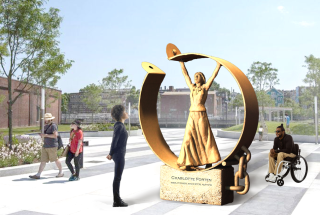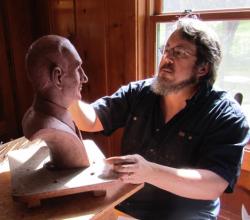Fortitude

Project Proposal Information
Meet young Charlotte Forten!
- We want our sculpture to show her at age 16, when she first arrived in Salem, to inspire today’s young people.
- People of color and women are rare in the sculptural landscape, but strong young women or girls are even rarer!
- This photo, from Salem State University, shows Charlotte as an adolescent.
- Charlotte had courage, she was strong, and she used her voice to work for change.
Concept Proposal: “Fortitude”
- Definition: strength of mind that enables a person to encounter danger or bear adversity with courage.
- We wanted to show young Charlotte in a powerful pose - ‘lifting up’ her people by pushing open a giant shackle. This is representative of the work she would do towards abolishing slavery, to free former slaves from the prison of illiteracy, and to work towards attaining equal rights for women.
- We wanted her to look heroic, and to make the vision of who she was and what she did obvious even to people casually driving by on Derby Street.
- The fact that many of her people were still slaves when she arrived in Salem hung heavily in her thoughts; so we show the shackle overshadowing her young form.
- And yet, what she’s doing is making a difference. The shackel has burst its rivet, and is now broken! She gazes up at the open sky with hope for the future.
- The model was too small to give her a proper face. Please see the next page for her portrait.
Portrait of Charlotte
- (What she looks like when she smiles!)
The monument in Charlotte Forten Park.
How this monument fits into the park:
- Placement at the front/right side of the park clearly establishes who this park honors.
- Open design ensures a clean view through the monument to the rest of the park, to welcome people in.
- Strong circular form echoes the curved retaining walls inside the park.
Meet young Charlotte Forten!
- We want our sculpture to show her at age 16, when she first arrived in Salem, to inspire today’s young people.
- People of color and women are rare in the sculptural landscape, but strong young women or girls are even rarer!
- This photo, from Salem State University, shows Charlotte as an adolescent.
Charlotte Louise Bridges Forten had Courage
- For any 16-year-old, leaving the warm embrace of family to move to a new city, to attend school for the first time, took great courage.
- But to be the first and only Black student at that school? We imagine Ruby Bridges-level courage! (Might they be related?)
- Then to navigate a world where free people of color could be kidnapped and sold into slavery (as Solomon Northup, who wrote “Twelve Years a Slave” could have attested). THAT took a superhero level of courage!
- Charlotte walked that perilous world, alone, and often.
Charlotte had Strength
- As if being Black in an uncertain world wasn’t enough, Charlotte was also female and still, technically a child. Children were expected to be seen but not heard. Women did not have the right to vote and were not expected to be politically or physically active.
- Women’s clothing at the time was equally restrictive, with corsets, stays, layers of petticoats and sleeves that weren’t designed for arms that did any work beyond cradling a baby.
- Charlotte bucked that tradition too according to her diary - by donning a ‘Bloomer costume’ (a controversial Victorian version of pants) to climb a cherry tree and pick fruit.
Charlotte had Purpose!
Raised in the activist abolitionist Forten family, Charlotte was deeply committed to the cause of freedom, justice and equality.
- Charlotte’s father Robert came to Boston for the Anthony Burns trial, which Charlotte also followed. Both were angry and upset when Burns was sent back to life as a slave. Robert was so disgusted, he moved the rest of his family to Canada, and then to England.
- 1855 - Charlotte joins the Salem Female Anti-Slavery Society.
- 1857 - Charlotte becomes the first Black teacher in Salem at the Epes Grammar School.
- 1861- Civil War begins.
- 1862 - Charlotte sails to Port Royal, South Carolina to teach some of the 10,000 formerly enslaved people there to read as part of the Port Royal Experiment - a "rehearsal for Reconstruction."
- 1863 - Charlotte meets Harriet Tubman and later, the 54th Massachusetts Regiment and tends their wounded (including Frederick Douglass’ son Lewis) after the Battle of Ft. Wagner.
- 1864 - Charlotte resigns position in Port Royal.
- 1865 - Civil War ends.
- 1868 - Charlotte is elected vice-president of the National Women’s Rights Convention.
- 1878 - Charlotte marries Francis Grimke, whose family was even more politically active than the Fortens.
- 1896 - Charlotte helped found National Association of Colored Women.
- She remained active in the civil rights movement until her death on July 23, 1914
Charlotte’s father, Robert Bridges Forten (above) and a document from the Library of Congress illustrating the stages in Anthony Burns’ enslavement, escape, capture and trial 1854-5
Charlotte used her voice
- When Charlotte was in Port Royal, she wrote about her experiences there and was published in the Liberator and in The Atlantic.
- These adventurous accounts were, for many Northern audiences, the first literature that presented the formerly enslaved as sympathetic, fellow human beings; and gave her audience a fresh perspective on the importance of the Civil War.
- As a young woman, Charlotte had all the ingredients needed to be a civil rights hero, and at 16 she was well on her way to the achievements of her maturity.
Concept Proposal: “Fortitude”
Justice
Charlotte bravely fought to free those held in bondage and in ignorance.
Invitational
The bold image of a woman breaking a shackle grabs the eye, and makes people want to know her story.
Connectivity
Her family and community nurtured her will to fight to abolish slavery and to give women full citizenship. Her diaries offer a unique insight into the birth of the civil rights movement.
Accessible
This monument was designed to work so that both seated and standing visitors can get up close to it, with no sharp edges or protrusions.
Inspirational
Her courage, resilience, boldness and strength inspires everyone to do what they can for social justice today.
Relatable
She was a Black woman when slavery still existed, when women had no vote, no say in government. Yet she was able to accomplish so much
- Shackle diameter: 5’ 10”
- Shackle thickness: 2”
- Base height: 21”
- Base width: 42”
- Base depth: 19.25”
- Figure height: 5’ 2”
- Sculpture & base total height: 7.58 feet.
- Nine feet at open clasp.
Placement of the sculpture in Charlotte Forten Park.
- Parallel to the sidewalk but set back far enough that viewers won’t block the public walk.
- Set forward enough that it won’t get in the way of festivals, concerts or Friday Night Family Bingo inside the park.
- Visible from picnic tables across the street.
- With 12’ to 18’ ease on all sides for emergency vehicle access.
- Set away from any drains.
- Far enough from the river that flooding should not be an issue (and even if it does flood, bronze is pretty indestructible.
FLOOD RISK CONSIDERATION: Our Tom Lee Monument in Memphis, (above) flooded by the mighty Mississippi in 2011. (Below) no repairs were needed!
Community Engagement
1. The creative community engagement strategy generated at the start of this process informed the creation of our proposal. We listened, and we will hear your feedback on this concept throughout the process.
2. The public wanted a sculpture of equal weight to the existing bronzes of white men in town. We could not match their massive granite bases with this budget, but we could give the sculpture extra size and importance by having Charlotte force open a giant shackle.
3. We welcome the community to tell us what Charlotte means to them. We will incorporate their thoughts onto the rear of the sculpture base (artist’s concept at right) or we could utilize the word groupings developed during the community engagement strategy.
4. Our sculpture of Charlotte is intended to become an active member of her community. We can imagine people involving her in future events as she bears witness to the progress taking place in her former and current home.
We love it when a sculpture we’ve created becomes an active part of its community!
Above, the Texas A&M community and the relatives of Reconstruction-era State Sen. Matthew Gaines (who was instrumental in establishing land grant colleges in Texas) gather for the dedication of his statue, newly unveiled at center left in 2021.
Right, the Memphis interfaith community performs a blessing and re-dedication on the Tom Lee Monument (which was installed in 2006) last week. This sculpture is at the heart of the city’s $60M new riverfront development project. The sculpture has also been used as a backdrop for the local chapter of Amnesty International’s annual Human Rights Awards.
Thank you for inviting us to present our idea.
Our working style values teamwork above all else. Like any good teammember, we know that clear communication is key. We strive to be open to all feedback and ideas that come our way because we know that a cooperative effort is more likely to reach our shared goal of an iconic sculpture in a landmark location.
Part of that is including the committee on the approval stages to come (should we be favored with this commission): small maquette approval, approval of the large maquette and final approval of the bronze and it’s patina at the foundry (done by video conference, photos or both.)
In our view, we are only partway done with the creative process. We look forward, hopefully, to completing it with all of you.
Artist Bio

David Alan Clark and MJ Clark have been life and business partners for 36 years. To date, they have been commissioned to create more than 58 larger than life-sized permanent public monuments, placed in cities, colleges and private businesses across the US.
They prefer to focus on the full spectrum of American History, which means shining a light on the historically overlooked: women and people of color. As part of this effort, they have created the Tom Lee Monument in Memphis; four Civil Rights Heroes for the City of Atlanta; a Reconstruction-era Texas State Senator for Texas A&M; four sports heroes for Texas Christian University (including James Cash, who broke the color barrier in the Southwest Conference). Upcoming work includes two separate monuments of Dr. Martin Luther King Jr. for sister cities in Michigan; a monument to the 1885 Chinese Massacre in Rock Springs, Wyoming; and a portrait of college basketball great David Thompson for North Carolina State.
Their entire body of work consists of monuments celebrating the local hero of each place. They listen and work collaboratively with their clients to create artwork that speaks to each community. Historic portraits are their specialty, and while they base their concepts on rigorous research, they like to blend traditional themes with modern interpretations to tell even ancient history in ways that appeal to today’s audiences.

